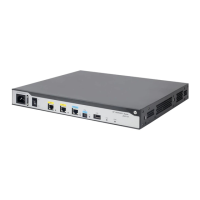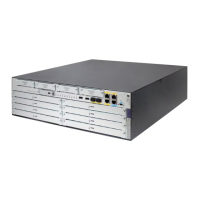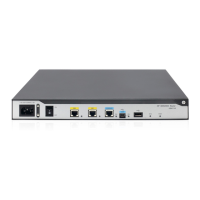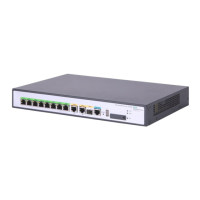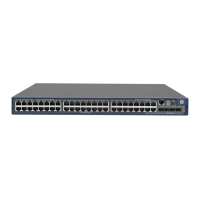110
NOTE:
Generally, a BSR performs BSM semantic fragmentation according to the MTU of its BSR interface.
For BSMs originated due to learning of a new PIM neighbor, semantic fragmentation is performed
according to the MTU of the interface that sends the BSMs.
Disabling BSM forwarding out of incoming interfaces
By default, the device is enabled to forward BSMs out of incoming interfaces. This feature avoids
devices in the PIM-SM domain might from failing to receive BSMs due to inconsistent routing
information. To reduce traffic, you can disable this feature if all the devices have consistent routing
information.
To disable the device from sending BSMs out of incoming interfaces:
1. Enter system view.
system-view
N/A
2. Enter PIM view.
pim
[
vpn-instance
vpn-instance-name ]
N/A
3. D
isable the device from
sending BSMs out of
incoming interfaces.
undo bsm-reflection
enable
By default, the device is enabled
to forward BSMs out of incoming
interfaces.
Configuring multicast source registration
A PIM register policy enables an RP to filter register messages by using an ACL that specifies the
multicast sources and groups. The policy limits the multicast groups to which the RP is designated. If
a register message is denied by the ACL or does not match the ACL, the RP discards the register
message and sends a register-stop message to the source-side DR. The registration process stops.
You can configure the device to calculate the checksum based on the entire register message to
ensure information integrity of a register message in the transmission process. If a device that does
not support this feature is present on the network, you can configure the device to calculate the
checksum based on the register message header.
The RP sends a register-stop message to the source-side DR in either of the following conditions:
The RP stops serving the receivers for a multicast group. The receivers do not receive multicast
data addressed to the multicast group through the RP.
The RP receives multicast data that travels along the SPT.
After receiving the register-stop message, the DR stops sending register messages encapsulated
with multicast data and starts a register-stop timer. Before the register-stop timer expires, the DR
sends a null register message (a register message without encapsulated multicast data) to the RP
and starts a register probe timer. If the DR receives a register-stop message before the register
probe timer expires, it resets its register-stop timer. Otherwise, the DR starts sending register
messages with encapsulated data again.
The register-stop timer is set to a random value chosen uniformly from (0.5 ×
register_suppression_time minus register_probe_time) to (1.5 × register_suppression_time minus
register_probe_time). The register_probe_time is fixed to 5 seconds.
On all C-RP routers, perform the following tasks:
Configure a PIM register policy.
Configure the routers to calculate the checksum based on the entire register messages or the
register message header.
On all routers that might become the source-side DR, configure the register suppression time.
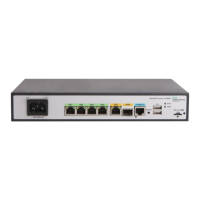
